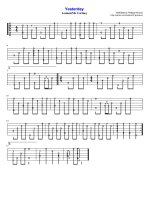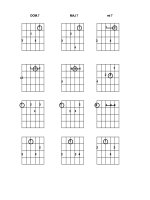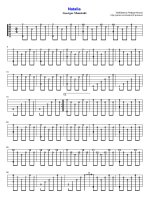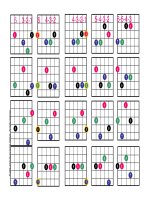Session 07 XP tủ tài liệu bách khoa
Bạn đang xem bản rút gọn của tài liệu. Xem và tải ngay bản đầy đủ của tài liệu tại đây (3.31 MB, 66 trang )
Fundamentals of Java
Describe methods
Explain the process of creation and invocation of methods
Explain passing and returning values from methods
Explain variable argument methods
Describe the use of Javadoc to lookup methods
Describe access specifiers and the types of access specifiers
Explain the use of access specifiers with methods
Explain the concept of method overloading
Explain the use of this keyword
© Aptech Ltd.
Methods and Access Specifiers/Session 7
2
Methods in Java are such a feature that allows grouping of statements and
execution of a specific set of statements instead of executing the entire
program.
Java provides a set of access specifiers that can help the user to restrict access
to certain methods.
© Aptech Ltd.
Methods and Access Specifiers/Session 7
3
A Java method can be defined as a set of statements grouped together for
performing a specific task.
For example, a call to the main() method which is the point of entry of any Java
program, will execute all the statements written within the scope of the main()
method.
The syntax for declaring a method is as follows:
Syntax
modifier return_type method_name([list_of_parameters]) {
// Body of the method
}
where,
modifier: Specifies the visibility of the method. Visibility indicates which object
can access the method. The values can be public, private, or protected.
return_type: Specifies the data type of the value returned by the method.
method_name: Specifies the name of the method.
list_of_parameters: Specifies the comma-delimited list of values passed to
the method.
© Aptech Ltd.
Methods and Access Specifiers/Session 7
4
Generally, a method declaration has the following six components, in order:
1
2
3
• Modifiers such as public, private, and protected.
• A return type that indicates the data type of the value returned by the method.
• The return type is set to void if the method does not return a value.
• The method name that is specified based on certain rules. A method name:
© Aptech Ltd.
cannot be a Java keyword
cannot have spaces
cannot begin with a digit
cannot begin with any symbol other than a $ or _
can be a verb in lowercase
can be a multi-word name that begins with a verb in lowercase, followed
by adjectives or nouns
can be a multi-word name with the first letter of the second word and
each of the following words capitalized
should be descriptive and meaningful
Methods and Access Specifiers/Session 7
5
Some valid method names are add, _view, $calc, add_num, setFirstName,
compareTo, isValid, and so on.
4
• Parameter list in parenthesis is separated with a comma delimiter.
• Each parameter is preceded by its data type.
• If there are no parameters, an empty parenthesis is used.
5
• An exception list that specifies the names of exceptions that can be thrown by
the method.
• An exception is an event encountered during the execution of the program,
disrupting the flow of program execution.
6
• Method body consists of a set of statements enclosed between curly braces ‘{}’.
• Method body can have variables, method calls, and even classes.
The two components of a method declaration namely, the method name and the
parameter types comprise the method signature.
© Aptech Ltd.
Methods and Access Specifiers/Session 7
6
Methods help to segregate tasks to provide modularity to the program.
A program is modular when different tasks in a program are grouped together into
modules or sections.
For example, to perform different types of mathematical operations such as addition,
subtraction, multiplication, and so on, a user can create individual methods as shown
in the following figure:
The figure shows an object named obj accessing four different methods namely,
add(a,b), sub(a,b), mul(a,b), and div(a,b) for performing the respective
operations on two numbers.
© Aptech Ltd.
Methods and Access Specifiers/Session 7
7
To create a method that adds two numbers, the user can write a method as depicted
in the following code snippet:
public void add(int num1, int num2){
int num3; // Declare a variable
num3 = num1 + num2; // Perform the addition of numbers
System.out.println(“Addition is ” + num3); // Print the result
}
Defines a method named add() that accepts two integer parameters num1 and
num2.
Has declared the method with the public access specifier which means that it can
be accessed by all objects.
Has set the return type to void, indicating that the method does not return anything.
Statement ‘int num3;’ is a declaration of an integer variable named num3.
Statement ‘num3 = num1 + num2;’ is an addition operation performed on
parameters num1 and num2 using the arithmetic operator ‘+’.
Result is stored in a third variable num3 by using the assignment operator ‘=’.
Finally, ‘System.out.println(“Addition is ”+ num3);’ is used to print
the value of variable num3.
Method signature is ‘add(int, int)’.
© Aptech Ltd.
Methods and Access Specifiers/Session 7
8
To use a method, it must be called or invoked. When a program calls a method, the
control is transferred to the called method.
The called method executes and returns control to the caller.
The call is returned back after the return statement of a method is executed or when
the closing brace is reached.
A method can be invoked in one of the following ways:
If the method returns a value, then, a call to the method results in return of
some value from the method to the caller. For example,
int result = obj.add(20, 30);
If the method’s return type is set to void, then, a call to the method results in
execution of the statements within the method without returning any value to
the caller.
For example, a call to the method would be obj.add(23,30) without
anything returned to the caller.
© Aptech Ltd.
Methods and Access Specifiers/Session 7
9
Consider the project Session7 created in the NetBeans IDE as shown in the
following figure:
The project consists of a package named session7 with the Calculator class that
has the main() method.
Several methods for mathematical operations can be added to the class.
© Aptech Ltd.
Methods and Access Specifiers/Session 7
10
Following code snippet demonstrates an example of creation and invocation of
methods:
package session7;
public class Calculator {
// Method to add two integers
public void add(int num1, int num2) {
int num3;
num3 = num1 + num2;
System.out.println(“Result after addition is “ + num3);
}
// Method to subtract two integers
public void sub(int num1, int num2) {
int num3;
num3 = num1 - num2;
System.out.println(“Result after subtraction is “ + num3);
}
// Method to multiply two integers
public void mul(int num1, int num2) {
int num3;
num3 = num1 * num2;
System.out.println(“Result after multiplication is “ + num3);
}
© Aptech Ltd.
Methods and Access Specifiers/Session 7
11
// Method to divide two integers
public void div(int num1, int num2) {
int num3;
num3 = num1 / num2;
System.out.println(“Result after division is “ + num3);
}
/**
* @param args the command line arguments
*/
public static void main(String[] args) {
// Instantiate the Calculator class
Calculator objCalc = new Calculator();
// Invoke the methods with appropriate arguments
objCalc.add(3, 4);
objCalc.mul(3, 4);
}
}
© Aptech Ltd.
Methods and Access Specifiers/Session 7
12
Class Calculator consists of methods such as add(), sub(), mul(), and div()
that are used to perform the respective operations.
Each method accepts two integers as parameters.
The main() method creates an object, objCalc of class Calculator.
The object objCalc uses the dot ‘.’ operator to invoke the add() and mul()
methods.
Following figure shows the output of the program:
© Aptech Ltd.
Methods and Access Specifiers/Session 7
13
Parameters
Parameters are the list of variables
specified in a method declaration.
Arguments
Arguments are the actual values that are
passed to the method when it is invoked.
When a method is invoked, the type and order of arguments that are passed must
match the type and order of parameters declared in the method.
A method can accept primitive data types such as int, float, double, and so on
as well as reference data types such as arrays and objects as a parameter.
value
Arguments can be
passed by
reference
© Aptech Ltd.
Methods and Access Specifiers/Session 7
14
When arguments are passed by value it is known as call-by-value and it means that:
A copy of the argument is passed from the calling method to the called method.
Changes made to the argument passed in the called method will not modify the
value in the calling method.
Variables of primitive data types such as int and float are passed by value.
Following code snippet demonstrates an example of passing arguments by value:
package session7;
public class PassByValue {
// method accepting the argument by value
public void setVal(int num1) {
num1 = num1 + 10;
}
© Aptech Ltd.
Methods and Access Specifiers/Session 7
15
public static void main(String[] args) {
// Declare and initialize a local variable
int num1 = 10;
// Instantiate the PassByValue class
PassByValue obj = new PassByValue();
// Invoke the setVal() method with num1 as parameter
obj.setVal(num1);
// Print num1 to check its value
System.out.println(“Value of num1 after invoking setVal is “+ num1);
}
}
Following figure shows the output of the code:
Output shows that the value of num1 is still 10 even after invoking setVal()
method when the value had been incremented.
This is because, num1 was passed by value.
© Aptech Ltd.
Methods and Access Specifiers/Session 7
16
When arguments are passed by reference it means that:
The actual memory location of the argument is passed to the called method and
the object or a copy of the object is not passed.
The called method can change the value of the argument passed to it.
Variables of reference types such as objects are passed to the methods by
reference.
There are two references of the same object namely, argument reference variable
and parameter reference variable.
Following code snippet demonstrates an example of passing arguments by reference:
package session7;
class Circle{
// Method to retrieve value of PI
public double getPI(){
return 3.14;
}
}
© Aptech Ltd.
Methods and Access Specifiers/Session 7
17
// Define another class PassByRef
public class PassByRef{
// Method to calculate area of a circle that
// takes the object of class Circle as a parameter
public void calcArea(Circle objPi, double rad){
// Use getPI() method to retrieve the value of PI
double area= objPi.getPI() * rad * rad;
// Print the value of area of circle
System.out.println(“Area of the circle is “+ area);
}
public static void main(String[] args){
// Instantiate the PassByRef class
PassByRef p1 = new PassByRef();
// Invoke the calcArea() method with object of class Circle as
// a parameter
p1.calcArea(new Circle(), 2);
}
}
© Aptech Ltd.
Methods and Access Specifiers/Session 7
18
Following figure shows the output of the code:
Note that the value of PI is passed by reference and not by value.
© Aptech Ltd.
Methods and Access Specifiers/Session 7
19
A method will return a value to the invoking method only when all the statements
in the invoking method are complete, or when it encounters a return statement, or
when an exception is thrown.
The return statement is written within the body of the method to return a value.
A void method will not have a return type specified in its method body.
A compiler error is generated when a void method returns a value.
You can store the value in a variable and specify the name of the variable with the
return keyword.
© Aptech Ltd.
Methods and Access Specifiers/Session 7
20
For example, the class Circle and its getPI() method can be modified as shown in
code snippet:
public class Circle {
// Declare and initialize value of PI
private double PI = 3.14;
// Method to retrieve value of PI
public double getPI(){
return PI;
}
}
In the modified class Circle, the value 3.14 is stored in a private double
variable PI.
Later, the method getPI() returns the value stored in the variable PI instead of the
constant value 3.14.
© Aptech Ltd.
Methods and Access Specifiers/Session 7
21
Java provides a feature called varargs to pass variable number of arguments to a
method.
varargs is used when the number of a particular type of argument that will be
passed to a method is not known until runtime.
It serves as a shortcut to creating an array manually.
To use varargs, the type of the last parameter is followed by ellipsis (...), then, a
space, followed by the name of the parameter.
This method can be called with any number of values for that parameter, including
none.
The syntax of a variable argument method is as follows:
Syntax
<method_name>(type … variableName){
// method body
}
where,
‘…’: Indicates the variable number of arguments.
© Aptech Ltd.
Methods and Access Specifiers/Session 7
22
Following code snippet demonstrates an example of a variable argument method:
package session7;
public class Varargs {
// Variable argument method taking variable number of integer arguments
public void addNumber(int...num) {
int sum=0;
// Use for loop to iterate through num
for(int i:num) {
// Add up the values
sum = sum + i;
}
// Print the sum
System.out.println(“Sum of numbers is “+ sum);
}
public static void main(String[] args) {
// Instantiate the Varargs class
Varargs obj = new Varargs();
// Invoke the addNumber() method with multiple arguments
obj.addNumber(10,30,20,40);
}
}
© Aptech Ltd.
Methods and Access Specifiers/Session 7
23
Following figure shows the output of the code:
The class Varargs consists of a method called addNumber(int…num).
The method accepts variable number of arguments of type integer.
The method uses the enhanced for loop to iterate through the variable argument
parameter num and adds each value with the variable sum.
Finally, the method prints the value of sum.
The main() method creates an object of the class and invokes the addNumber()
method with multiple arguments of type integer.
The output displays 100 after adding up the numbers.
© Aptech Ltd.
Methods and Access Specifiers/Session 7
24
Java provides a JDK tool named Javadoc that is used to generate API documentation as
an HTML page from declaration and documentation comments.
These comments are descriptions of the code written in a program.
The different terminologies used while generating javadoc are as follows:
API documentation or API docs
• Are the online or hard copy descriptions of the API that are primarily intended for
the programmers.
• API specification consists of all assertions for a proper implementation of the Java
platform to ensure that the ‘write once, run anywhere’ feature of Java is retained.
Documentation comments or doc comments
• Are special comments in the Java source code.
• Are written within the /** … */ delimiters.
• Are processed by the Javadoc tool for generating the API docs.
© Aptech Ltd.
Methods and Access Specifiers/Session 7
25









